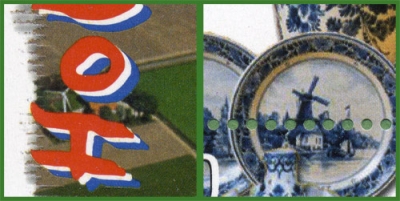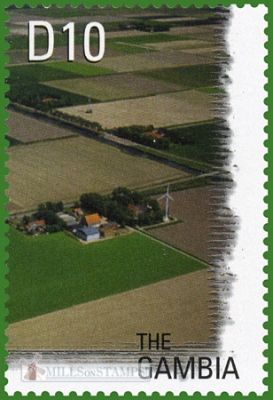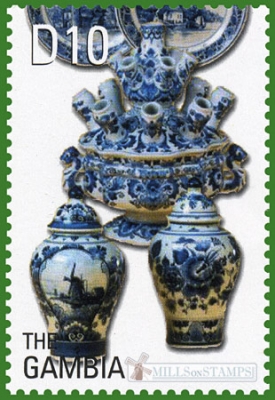-
Amphilex 2002. Intl. Stamp Exhibition, Amsterdam
Gambia, The 2002.08.30
In issue: Stamp(s): 21 Sheet(s): 4
Issued in: mini sheets with different themes sets (sheets of 6, 6, 6, and 3 stamps)
-
Number by catalogue: Yvert: 3845-3850 Scott: 2658
Perforation type: 13 ½x13 ¼
Subject:
The sheet includes 6 stamps with the various Dutch plots joined in the general collage.
Except the wind turbie and mill on two stamps, they are also on fields of the sheet (see the fragments)Size (of sheet, booklet) mm: 130x130
Topics: Mills in Art Mills within the landscapes Wind pumps and farm windmill Wind turbines Windmills
-
Number by catalogue: Yvert: 3845 Scott: 2658a
Subject:
10 dalasi. Dutch fields and farms from the height of bird flight.
-
Number by catalogue: Yvert: 3846 Scott: 2658b
Subject:
10 dalasi. Classic Dutch porcelain*.
Additional:
*Delftware, or Delft pottery, denotes blue and white pottery made in and around Delft in the Netherlands and the tin-glazed pottery made in the Netherlands from the sixteenth to the eighteenth centuries.
Delftware in the latter sense is a type of pottery in which a white glaze is applied, usually decorated with metal oxides. Delftware includes pottery objects of all descriptions such as plates, ornaments and tiles.
The earliest tin-glazed pottery in the Netherlands was made in Antwerp by Guido da Savino in 1512. The manufacture of painted pottery may have spread from the south to the northern Netherlands sometime during the 1560s. It was made in Middelburg and Haarlem in the 1570s and in Amsterdam in the 1580s. Much of the finer work was produced in Delft, but simple everyday tin-glazed pottery was made in places such as Gouda, Rotterdam, Amsterdam and Dordrecht.
The main period of tin-glaze pottery in the Netherlands was 1640-1740. From about 1640 Delft potters began using personal monograms and distinctive factory marks. The Guild of St Luke, to which painters in all media had to belong, admitted ten master potters in the thirty years between 1610 and 1640 and twenty in the nine years 1651 to 1660. In 1654 a gunpowder explosion in Delft destroyed many breweries and as the brewing industry was in decline they became available to pottery makers looking for larger premises; some retained the old brewery names, making them famous throughout northern Europe, e.g. The Double Tankard, The Young Moors' Head and The Three Bells.
The use of marl, a type of clay rich in calcium compounds, allowed the Dutch potters to refine their technique and to make finer items. The usual clay body of Delftware was a blend of three natural clays, one local, one from Tournai and one from the Rhineland.
From about 1615, the potters began to coat their pots completely in white tin glaze instead of covering only the painting surface and coating the rest with clear glaze. They then began to cover the tin-glaze with clear glaze, which gave depth to the fired surface and smoothness to cobalt blues, ultimately creating a good resemblance to porcelain.
During the Dutch Golden Age, the Dutch East India Company had a lively trade with the East and imported millions of pieces of Chinese porcelain in the early 1600s. The Chinese workmanship and attention to detail impressed many. Only the richest could afford the early imports. Although Dutch potters did not immediately imitate Chinese porcelain, they began to do after the death of the Wanli Emperor in 1620, when the supply to Europe was interrupted. Delftware inspired by Chinese originals persisted from about 1630 to the mid-eighteenth century alongside European patterns.
By about 1700 several factories were using enamel colours and gilding over tin-glaze, requiring a third kiln firing at a lower temperature.
Delftware ranged from simple household items - plain white earthenware with little or no decoration - to fancy artwork. Most of the Delft factories made sets of jars, the kast-stel set. Pictorial plates were made in abundance, illustrated with religious motifs, native Dutch scenes with windmills and fishing boats, hunting scenes, landscapes and seascapes. Sets of plates were made with the words and music of songs; dessert was served on them and when the plates were clear the company started singing. The Delft potters also made tiles in vast numbers (estimated at eight hundred million) over a period of two hundred years; many Dutch houses still have tiles that were fixed in the seventeenth and eighteenth centuries.
Delftware became popular and was widely exported in Europe and even reached China and Japan. Chinese and Japanese potters made porcelain versions of Delftware for export to Europe.
Some regard Delftware from about 1750 onwards as artistically inferior. Caiger-Smith says that most of the later wares "were painted with clever, ephemeral decoration. Little trace of feeling or originality remained to be lamented when at the end of the eighteenth century the Delftware potteries began to go out of business." By this time Delftware potters had lost their market to British porcelain and the new white earthenware. One or two remain: the Tichelaar factory in Makkum, Friesland, founded in 1594 and De Koninklijke Porceleyne Fles ("The Royal Porcelain Bottle") founded in 1653.
Today, Delfts Blauw (Delft Blue) is the brand name hand painted on the bottom of ceramic pieces identifying them as authentic and collectible. Although most Delft Blue borrows from the tin-glaze tradition, it is nearly all decorated in underglaze blue on a white clay body and very little uses tin glaze, a more expensive product. Delft Blue pottery formed the basis of one of British Airways' ethnic tailfins. The design, Delftblue Daybreak, was applied to 17 aircraft.________
This information has been taken from Wikipedia
Topics: Mills in Art Various Wind pumps and farm windmill Windmills


2002-sheet-logo.jpg)


